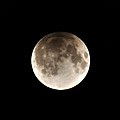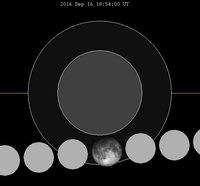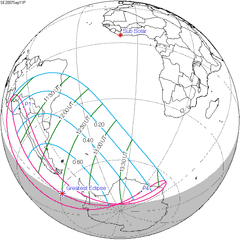| Penumbral eclipse | |||||||||
 Penumbral eclipse as viewed from Oria, Italy, 18:54 UTC Penumbral eclipse as viewed from Oria, Italy, 18:54 UTC | |||||||||
| Date | September 16, 2016 | ||||||||
|---|---|---|---|---|---|---|---|---|---|
| Gamma | 1.0548 | ||||||||
| Magnitude | −0.0624 | ||||||||
| Saros cycle | 147 (9 of 71) | ||||||||
| Penumbral | 239 minutes, 17 seconds | ||||||||
| |||||||||
| ← August 2016February 2017 → | |||||||||
A penumbral lunar eclipse occurred at the Moon’s descending node of orbit on Friday, September 16, 2016, with an umbral magnitude of −0.0624. A lunar eclipse occurs when the Moon moves into the Earth's shadow, causing the Moon to be darkened. A penumbral lunar eclipse occurs when part or all of the Moon's near side passes into the Earth's penumbra. Unlike a solar eclipse, which can only be viewed from a relatively small area of the world, a lunar eclipse may be viewed from anywhere on the night side of Earth. Occurring about 1.8 days before perigee (on September 18, 2016, at 13:00 UTC), the Moon's apparent diameter was larger.
Visibility
The eclipse was completely visible over east Africa, eastern Europe, Asia, and western Australia, seen rising over west Africa and western Europe and setting over eastern Australia and the western Pacific Ocean.

|
 Hourly motion shown right to left |
 Visibility map | |
Gallery

Progression as seen from Primorsko, Bulgaria
-
 Hefei, China, 18:03 UTC
Hefei, China, 18:03 UTC
-
 Huittinen, Finland, 18:51 UTC
Huittinen, Finland, 18:51 UTC
-
 Hong Kong, 19:00 UTC
Hong Kong, 19:00 UTC
-
 Rabka-Zdrój, Poland, 19:09 UTC
Rabka-Zdrój, Poland, 19:09 UTC
-
 Belfort, France, combined images
Belfort, France, combined images
-
 Progression from Belfort, France
Progression from Belfort, France
-
 Helmshore, England, 20:04 UTC
Helmshore, England, 20:04 UTC
Eclipse details
Shown below is a table displaying details about this particular solar eclipse. It describes various parameters pertaining to this eclipse.
| Parameter | Value |
|---|---|
| Penumbral Magnitude | 0.90912 |
| Umbral Magnitude | −0.06240 |
| Gamma | −1.05491 |
| Sun Right Ascension | 11h39m09.7s |
| Sun Declination | +02°15'14.2" |
| Sun Semi-Diameter | 15'54.8" |
| Sun Equatorial Horizontal Parallax | 08.7" |
| Moon Right Ascension | 23h40m27.3s |
| Moon Declination | -03°15'36.5" |
| Moon Semi-Diameter | 16'22.8" |
| Moon Equatorial Horizontal Parallax | 1°00'06.8" |
| ΔT | 68.2 s |
Eclipse season
See also: Eclipse cycleThis eclipse is part of an eclipse season, a period, roughly every six months, when eclipses occur. Only two (or occasionally three) eclipse seasons occur each year, and each season lasts about 35 days and repeats just short of six months (173 days) later; thus two full eclipse seasons always occur each year. Either two or three eclipses happen each eclipse season. In the sequence below, each eclipse is separated by a fortnight. The first and last eclipse in this sequence is separated by one synodic month.
| August 18 Descending node (full moon) |
September 1 Ascending node (new moon) |
September 16 Descending node (full moon) |
|---|---|---|
 |
 |

|
| Penumbral lunar eclipse Lunar Saros 109 |
Annular solar eclipse Solar Saros 135 |
Penumbral lunar eclipse Lunar Saros 147 |
Related eclipses
Eclipses in 2016
- A total solar eclipse on March 9.
- A penumbral lunar eclipse on March 23.
- A penumbral lunar eclipse on August 18.
- An annular solar eclipse on September 1.
- A penumbral lunar eclipse on September 16.
Metonic
- Preceded by: Lunar eclipse of November 28, 2012
- Followed by: Lunar eclipse of July 5, 2020
Tzolkinex
- Preceded by: Lunar eclipse of August 6, 2009
- Followed by: Lunar eclipse of October 28, 2023
Half-Saros
- Preceded by: Solar eclipse of September 11, 2007
- Followed by: Solar eclipse of September 21, 2025
Tritos
- Preceded by: Lunar eclipse of October 17, 2005
- Followed by: Lunar eclipse of August 17, 2027
Lunar Saros 147
- Preceded by: Lunar eclipse of September 6, 1998
- Followed by: Lunar eclipse of September 28, 2034
Inex
- Preceded by: Lunar eclipse of October 7, 1987
- Followed by: Lunar eclipse of August 27, 2045
Triad
- Preceded by: Lunar eclipse of November 17, 1929
- Followed by: Lunar eclipse of July 19, 2103
Lunar eclipses of 2013–2016
This eclipse is a member of a semester series. An eclipse in a semester series of lunar eclipses repeats approximately every 177 days and 4 hours (a semester) at alternating nodes of the Moon's orbit.
The penumbral lunar eclipse on May 25, 2013 occurs in the previous lunar year eclipse set, and the penumbral lunar eclipse on August 18, 2016 occurs in the next lunar year eclipse set.
| Lunar eclipse series sets from 2013 to 2016 | ||||||||
|---|---|---|---|---|---|---|---|---|
| Ascending node | Descending node | |||||||
| Saros | Date Viewing |
Type Chart |
Gamma | Saros | Date Viewing |
Type Chart |
Gamma | |
112
|
2013 Apr 25
|
Partial
|
−1.0121 | 117
|
2013 Oct 18
|
Penumbral
|
1.1508 | |
122
|
2014 Apr 15
|
Total
|
−0.3017 | 127
|
2014 Oct 08
|
Total
|
0.3827 | |
132
|
2015 Apr 04
|
Total
|
0.4460 | 137
|
2015 Sep 28
|
Total
|
−0.3296 | |
| 142 | 2016 Mar 23
|
Penumbral
|
1.1592 | 147
|
2016 Sep 16
|
Penumbral
|
−1.0549 | |
Half-Saros cycle
A lunar eclipse will be preceded and followed by solar eclipses by 9 years and 5.5 days (a half saros). This lunar eclipse is related to two partial solar eclipses of Solar Saros 154.
| September 11, 2007 | September 21, 2025 |
|---|---|

|

|
See also
- March 2016 lunar eclipse, the first 2016 lunar eclipse (penumbral)
- August 2016 lunar eclipse, the second 2016 lunar eclipse (penumbral)
- List of lunar eclipses and List of 21st-century lunar eclipses
References
- "September 16–17, 2016 Penumbral Lunar Eclipse". timeanddate. Retrieved 16 November 2024.
- "Moon Distances for London, United Kingdom, England". timeanddate. Retrieved 16 November 2024.
- "Penumbral Lunar Eclipse of 2016 Sep 16" (PDF). NASA. Retrieved 16 November 2024.
- "Penumbral Lunar Eclipse of 2016 Sep 16". EclipseWise.com. Retrieved 16 November 2024.
- van Gent, R.H. "Solar- and Lunar-Eclipse Predictions from Antiquity to the Present". A Catalogue of Eclipse Cycles. Utrecht University. Retrieved 6 October 2018.
- Mathematical Astronomy Morsels, Jean Meeus, p.110, Chapter 18, The half-saros
External links
- 2016 Sep 16 chart: Eclipse Predictions by Fred Espenak, NASA/GSFC
- Hermit eclipse: 23 Mar 2016 - Penumbral Lunar Eclipse
- Penumbral Lunar Eclipse On Sep. 16, 2016 by Giuseppe Donatiello, Oria, Italy
- Penumbral Lunar Eclipse on September 16, 2016 by Mulham Hindi, Makkah, Saudi Arabia
This lunar eclipse-related article is a stub. You can help Misplaced Pages by expanding it. |


